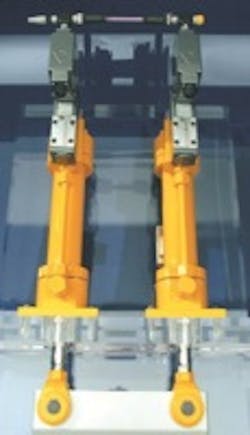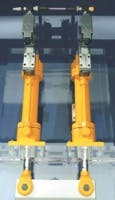Digital servovalves provide platen parallelism
Press brakes are machines that perform precise bending of large sheet metal pieces. And as in any industrial production environment, time is money, so high-speed operation is essential for maximum productivity.
Because press brakes bend large metal work pieces, high force is required, so hydraulic drives are widely used in these machines. Typically, a pair of hydraulic cylinders moves a platen downward to bend the work piece. Each cylinder is mounted to opposite ends of the platen, so the challenge is to extend and retract the cylinders at the same speed to keep the platen parallel with the stationary bed of the machine.
Keeping the platen parallel requires synchronizing motion of the cylinders. This can be done hydraulically, but with the advent of CANbus, PROFIBUS, and other digital control networks, closed-loop digital hydraulics becomes an attractive solution by integrating the press brake into factory automation networks.
A system developed by Atos spa, Sesto Calende, Italy, uses digital electrohydraulic proportional valves, digital controls, and cylinders with position feedback in press brakes with bending capacities to 1000 tonnes that achieve positioning accuracy to 0.01 mm and downstroking speeds to 250 mm/sec.
To achieve this combination of high force, high speed, and high positioning accuracy, the system uses a master-slave control scheme executed through a pair of Atos digital electrohydraulic proportional valves. Each valve drives an Atos servocylinder, a hydraulic cylinder with electronic feedback of position. The valves themselves have a zero-lapped spool, which produces rapid response typically associated with electrohydraulic servovalves. Each valve's spool is driven by a single proportional solenoid, and spool position is monitored by an integral LVDT. The LVDT feedback provides closed-loop position control of the valve spool within the valve's integral electronics.
The master-slave control maintains parallelism by routing a control signal to one servocylinder, the master. Position feedback from the master cylinder is routed to the slave servocylinder, so instead of following the main command signal, the slave servocylinder uses position of the master cylinder as its target. This simplifies the control because the slave cylinder is used only to maintain parallelism.
In some cases, operators may wish to control the press brake using control control. In this setup, the command from the main control is routed to both servocylinder drives simultaneously. With the conventional control, both servo axes use the command as their target position.
This information was provided by Fabio Balzarini, at Atos spa. For more information visit www.atos.com, or e-mail [email protected]


